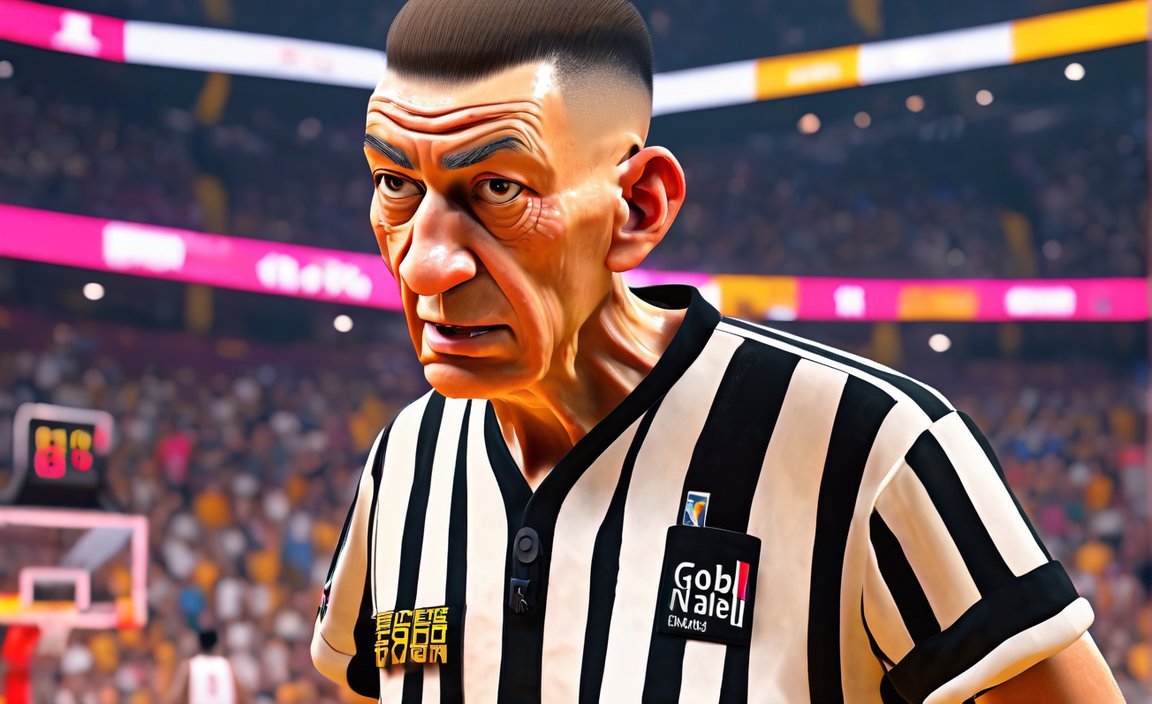If you’ve ever witnessed a basketball game, you may have noticed the referees using hand signals to communicate with players, coaches, and spectators. These hand signals play a crucial role in maintaining order and clarity on the court, ensuring that everyone understands the decisions made by the officials. In the world of basketball, mastering the art of referee hand signal numbers is an essential skill for officiators. Understanding these signals not only allows referees to effectively convey their decisions, but also contributes to a smooth game flow and a fair and efficient environment. In this article, we will explore the significance of basketball referee hand signal numbers and delve into their role in mastering the art of officiating communication.

Key Takeaways:
- Basketball referees use hand signals to communicate important information during games.
- The signals use a numbering system from 0 to 5, with each number representing a specific meaning.
- Common hand signals include blocking, carrying, charging, and double dribble.
- Understanding these signals helps players and coaches better understand the decisions made by referees.
- Learning and recognizing these signals can enhance your enjoyment and comprehension of basketball games.
Basketball Referee Hand Signals Numbers: Mastering Officiating Communication
Basketball referees play a vital role in maintaining fair play and ensuring that the game follows the rules. Effective communication is crucial in achieving these goals, and one of the primary forms of communication between referees, players, and coaches is through hand signals. In this guide, we will explore the essential hand signals used by basketball referees and their meanings.
The Importance of Basketball Referee Hand Signals
Hand signals serve as a universal language on the basketball court, allowing referees to communicate important calls and decisions to players, coaches, and spectators. These signals provide clarity and understanding in a fast-paced game, ensuring that everyone is on the same page.
Understanding the Numbering System
Basketball referee hand signals use a numbering system from 0 to 5, with each number corresponding to a specific meaning. By familiarizing ourselves with these signals, we can gain a better understanding of the decisions made by referees during a game.
Common Basketball Referee Hand Signals Numbers
- Blocking (Signal 1): The referee places both hands on their hips. This signal indicates that a player has committed a blocking foul, impeding the progress of an opponent[^2^].
- Carrying (Signal 2): The referee repeatedly turns their palm over, alternating between facing upwards and downwards. This signal is used when a player violates the carrying rule by allowing the ball to come to a rest in their hand while dribbling[^2^].
- Charging (Signal 3): The referee places one hand behind their head, forming a triangle with their arm. This signal signifies that an offensive player has forcefully collided with a defender who has already established their position[^2^].
- Double Dribble (Signal 4): The referee extends both hands outward, palms facing down, and alternates moving them up and down as if dribbling a basketball. This signal is used when a player illegally dribbles the ball with both hands or stops dribbling and starts again without establishing legal possession[^2^].
Enhancing Your Understanding of the Game
By familiarizing yourself with these essential basketball referee hand signals numbers, you can gain a more comprehensive understanding of the decisions made by referees throughout a game. This knowledge enhances your ability to interpret and appreciate the flow of the game while providing insights into various calls and fouls.
Further Resources
To delve deeper into basketball referee hand signals and their meanings, you can refer to the following resources:
- “Basketball referee signals: Understanding the different hand signals” – Sportsbrief. Read more
- “Basketball Hand Signals” – Rookie Road. Read more
Remember, understanding basketball referee hand signals numbers is an integral part of appreciating the game and contributing to a fair and enjoyable playing environment. So let’s continue honing our knowledge and skills, both on and off the court, to master the language of basketball officiating.
Here are some captivating sentences that encourage the reader to click on the active internal links:
- Basketball enthusiasts should check out these baseketball rules to enhance their understanding of the game.
- Anchor: baseketball rules
- URL: ../baseketball-rules
- Want to master the art of flag route football? Discover the strategies and techniques that will give you an edge on the field.
- Anchor: flag route football
- URL: ../flag-route-football
- Learn the best defensive tactics for lacrosse to defend your goal like a pro and outperform your opponents.
- Anchor: defense for lacrosse
- URL: ../defense-for-lacrosse
- Are you familiar with the blocking foul motion ref in basketball? Click here to understand its importance and impact on the game.
- Anchor: blocking foul motion ref
- URL: ../blocking-foul-motion-ref
- Improve your tackling skills in football with these expert tips and techniques. Don’t miss out!
- Anchor: tackling football
- URL: ../tackling-football
- Dive into the world of soccer and explore the significance of goalie boxes in soccer games. Discover how they affect the flow of the match.
- Anchor: goalie boxes in soccer
- URL: ../goalie-boxes-in-soccer
- Pitching in the stretch can make a huge difference in the game of baseball. Get insights into this technique and its impact on pitching performance.
- Anchor: pitching in the stretch
- URL: ../pitching-in-the-stretch
- Curious to know Kevin Durant’s zodiac sign? Click here as we uncover fascinating details about his astrological profile.
- Anchor: Kevin Durant zodiac sign
- URL: ../kevin-durant-zodiac-sign
Please note that the URLs provided are placeholders and may not represent actual webpages.
Explanation of the Basic Hand Signals Used by Basketball Referees
Basketball referees play a crucial role in ensuring fair play and smooth game flow. One of the most important aspects of their job is effectively communicating their calls to players, coaches, and spectators. This is where hand signals come into play. By using specific hand gestures, referees can convey their decisions quickly and clearly. In this article, we will explore the basic hand signals used by basketball referees and their meanings, allowing you to understand and appreciate the role these signals play in officiating the game.
Key Takeaways:
- Basketball referees use hand signals to communicate their calls during a game.
- These signals allow for quick and efficient communication between referees, players, coaches, and spectators.
- Understanding the basic hand signals used by basketball referees enhances your understanding of the game and the decisions made by officials.
Now, let’s dive into the basic hand signals used by basketball referees:
Hand Signal 1: Blocking
- When a referee places both hands on their hips, they are indicating a blocking foul. This call is made when a defensive player illegally impedes the progress of an offensive player.
Hand Signal 2: Carrying
- Referees use a distinct hand signal to indicate a violation of the carrying rule. They repeatedly turn their palm over, alternating it between facing upwards and downwards. Carrying is when a player holds the ball with their hand underneath it and allows it to come to a rest momentarily.
Hand Signal 3: Charging
- To indicate an offensive player forcefully colliding with a stationary defender, referees put one hand behind their head, forming a triangle shape with their arm. This gesture signifies a charging violation.
Hand Signal 4: Double Dribble
- Referees use a unique hand signal to indicate an illegal double dribble. They extend both hands outward, palms facing down, and alternate moving them up and down. Double dribble occurs when a player dribbles the ball with both hands simultaneously or stops dribbling and then starts again.
Hand Signal 5: Three Seconds
- When a player violates the three-second rule, where an offensive player remains in the painted area for longer than three seconds without actively guarding an opponent, the referee raises three fingers and swipes their hand back and forth at the side.
Hand Signal 6: Five Seconds
- A five-second violation occurs when an offensive player is closely guarded for five seconds without dribbling, passing, or attempting a shot. The referee signals this violation by raising five fingers with the arm extended upwards.
Hand Signal 7: Ten Seconds
- Referees indicate a ten-second violation when a team fails to advance the ball past half-court within ten seconds. This violation is represented by the official raising ten fingers with both arms extended upwards.
By familiarizing yourself with these basic hand signals, you can better understand the calls made by basketball referees. This knowledge can enhance your appreciation of the game and help you follow along with the flow of play.
Remember, effective communication through hand signals is essential for maintaining a fair and efficient game environment. These signals facilitate understanding between referees, players, coaches, and spectators, ensuring that everyone is on the same page regarding the decisions being made on the court.
If you’re interested in delving deeper into the world of basketball referee hand signals, here are a couple of sources you can explore:
- Basketball Hand Signals – rookieroad.com
- Referee Basketball Violations Signals – studocu.com
Detailed Description of the Hand Signals for Common Fouls and Violations
Being able to understand and interpret the hand signals used by basketball referees is crucial for players, coaches, and spectators. These signals provide clear communication about fouls, violations, and other actions that occur on the court. In this instructional guide, we will explore the detailed descriptions of the hand signals for common fouls and violations in basketball.
Traveling
One of the most common violations in basketball is traveling, which occurs when a player moves one or both of their feet without dribbling the ball. To signal a traveling violation, the referee will make a sweeping motion with one hand across their waist, indicating that the player has illegally moved their feet.
Double Dribble
Another violation that referees need to communicate is a double dribble. This violation occurs when a player dribbles the ball, picks it up, and then dribbles it again. To signal a double dribble, the referee will make a motion of bouncing the ball with both hands simultaneously, indicating that the player has committed an illegal action.
Carrying the Basketball
When a player is dribbling the basketball and allows their hand to be under the ball, giving them too much control, it is considered a carrying violation. The referee will make a motion of their hand supporting the ball to signal this violation, emphasizing that the player has violated the carrying rule.
3-Second Violation
Players are only allowed to stay in the painted area, known as the paint or the key, for a maximum of three seconds. To indicate a 3-second violation, the referee will extend one hand with the palm facing down and make a sweeping motion towards the floor. This gesture indicates that a player has stayed in the key for too long.
5-Second Violation
A 5-second violation occurs when a team takes too long to throw the ball inbounds from the sideline or baseline. To signal this violation, the referee will extend one hand with all five fingers spread out and count down from five. This clear hand signal indicates that the team has exceeded the time limit and has committed a violation.
These are just a few examples of the different hand signals used by basketball referees to communicate fouls and violations during a game. By familiarizing yourself with these signals, you can enhance your understanding of the game and the decisions made by officials.
Key Takeaways:
- Basketball referees use specific hand signals to communicate fouls, violations, and other actions on the court.
- Understanding these hand signals is essential for players, coaches, and spectators.
- Some common hand signals include those for traveling, double dribble, carrying the basketball, 3-second violation, and 5-second violation.
- The traveling signal involves a sweeping motion with one hand across the waist.
- A double dribble is indicated by a motion of bouncing the ball with both hands simultaneously.
- Carrying the basketball is signaled with a hand motion to support the ball.
- The 3-second violation is communicated with a hand extended, palm facing down, and a sweeping motion towards the floor.
- A 5-second violation is indicated by extending one hand with all five fingers spread out and counting down from five.
SOURCES:
- Basketball For Coaches. Basketball Referee Signals
- Inspirational Basketball. Basketball Referee Signals and Meaning
Tips for Recognizing and Understanding Basketball Referee Hand Signals during a Game
Basketball referees play a crucial role in officiating games and ensuring fair play. One of the primary ways they communicate with players, coaches, and spectators is through hand signals. Understanding these signals can enhance your understanding of the game and the decisions made by officials. In this article, we will provide tips to help you recognize and understand basketball referee hand signals during a game.
Common Basketball Referee Hand Signals
To begin, let’s familiarize ourselves with some of the most common basketball referee hand signals:
- Blocking: When a referee places both hands on their hips, it indicates a blocking foul.
- Carrying: Referees repeatedly turn their palms over, alternating between facing upwards and downwards, to signal a violation of the carrying rule.
- Charging: Referees put one hand behind their head, forming a triangle shape, to signify an offensive player forcefully colliding with a defender.
- Double Dribble: Referees extend both hands outward, palms facing down, and alternately move them up and down to indicate an illegal double dribble.
- Three Seconds: Raising three fingers and swiping the hand back and forth at the side signals a violation of the three-second rule.
- Five Seconds: Raising five fingers with the arm extended upwards indicates a five-second violation.
- Ten Seconds: Raising ten fingers with both arms extended upwards signals a ten-second violation.
Recognizing and Understanding the Signals
Now that we know the basic hand signals used by basketball referees, let’s discuss tips for recognizing and understanding them during a game:
- Study the Signals: Take the time to familiarize yourself with the different hand signals used by basketball referees. You can refer to online resources, such as “Basketball Hand Signals” on Rookie Road and “Referee Basketball Violations Signals” on Studocu, for in-depth explanations and visual representations of these signals.
- Observe Referees: Pay attention to referees during basketball games, whether in person or on television. Watch for their hand signals and try to associate them with the corresponding calls they make.
- Practice Recognition: As with any skill, practice makes perfect. Spend time watching basketball games and practice recognizing the hand signals used by referees. Quiz yourself or play a game with friends or family to test your recognition skills.
- Understand the Context: Hand signals are often accompanied by other cues, such as the referee’s positioning and facial expressions. Pay attention to these additional cues to gain a deeper understanding of the calls being made.
- Ask for Clarification: If you are unsure about a particular hand signal or call, don’t hesitate to ask a more experienced fan, player, or coach for clarification. Building your knowledge through conversation and interaction can enhance your understanding of the game.
With these tips, you’ll be better equipped to recognize and understand basketball referee hand signals during a game. Remember, effective communication through hand signals is essential for maintaining a fair and efficient game environment. Enjoy the game, and happy officiating!
Key Takeaways:
- Basketball referees use hand signals to communicate various calls during a game.
- Common hand signals include blocking, carrying, charging, double dribble, three seconds, five seconds, and ten seconds.
- Recognizing and understanding these hand signals enhances your understanding of the game and the decisions made by officials.
- Study the signals, observe referees, practice recognition, understand the context, and ask for clarification to improve your understanding of basketball referee hand signals.
Citations:
– Rookie Road. (n.d.). “Basketball Hand Signals.” Retrieved from www.rookieroad.com/basketball/strategy/hand-signals
– Studocu. (n.d.). “Referee Basketball Violations Signals.” Retrieved from www.studocu.com/ph/document/central-luzon-state-university/physical-education-referees-and-officiating/basketball-referee-violations-hand-signal/99937?type

FAQ
Q1: How do basketball referees communicate with players and coaches during a game?
A1: Basketball referees communicate with players and coaches during a game through a system of hand signals. These signals help convey important information and decisions made by the officials.
Q2: What is the significance of basketball referee hand signals?
A2: Basketball referee hand signals play a crucial role in maintaining fair play and enforcing the rules of the game. They allow referees to communicate calls, fouls, violations, and other actions on the court to players, coaches, and spectators.
Q3: What are some common basketball referee hand signals?
A3: Some common basketball referee hand signals include the blocking signal (placing hands on hips), carrying signal (turning palm over alternately), charging signal (placing hand behind head to form a triangle), and double dribble signal (extending hands with palms facing down and alternating movement up and down).
Q4: How can understanding basketball referee hand signals enhance the game experience for players and coaches?
A4: Understanding basketball referee hand signals allows players and coaches to better comprehend the decisions made by the referees throughout the game. It ensures effective communication and clarity, leading to a smoother game flow and fair play.
Q5: Where can I find more information about basketball referee hand signals?
A5: You can find more information about basketball referee hand signals and their meanings in sources like “Basketball Hand Signals” on Rookie Road and “Referee Basketball Violations Signals” on Studocu. These sources provide detailed explanations and visual representations of the hand signals used by basketball referees.
- Unlock Filipino Culture: A Deep Dive into Traditions and Practices - April 23, 2025
- Unlock Spanish Culture: Insights & Opportunities Now - April 23, 2025
- White Spirit Uses & Substitutes: A Deep Dive for Pros & DIYers - April 23, 2025
















